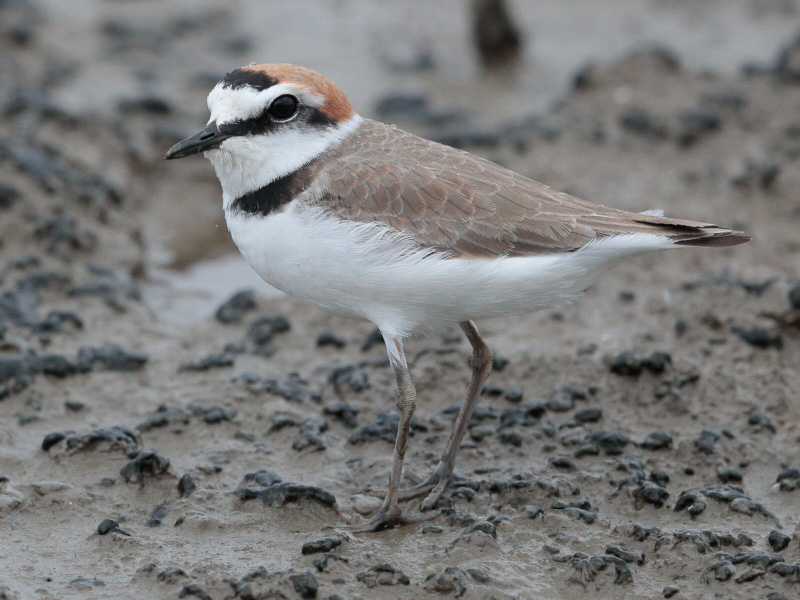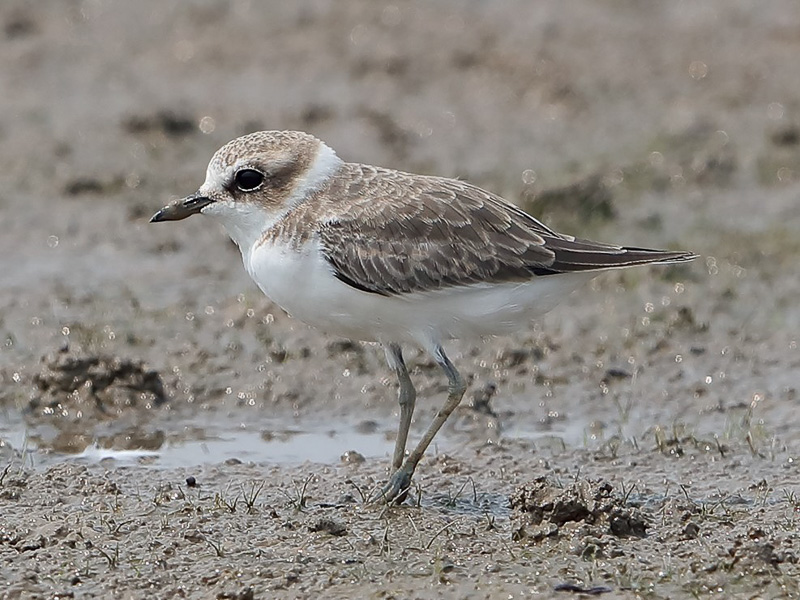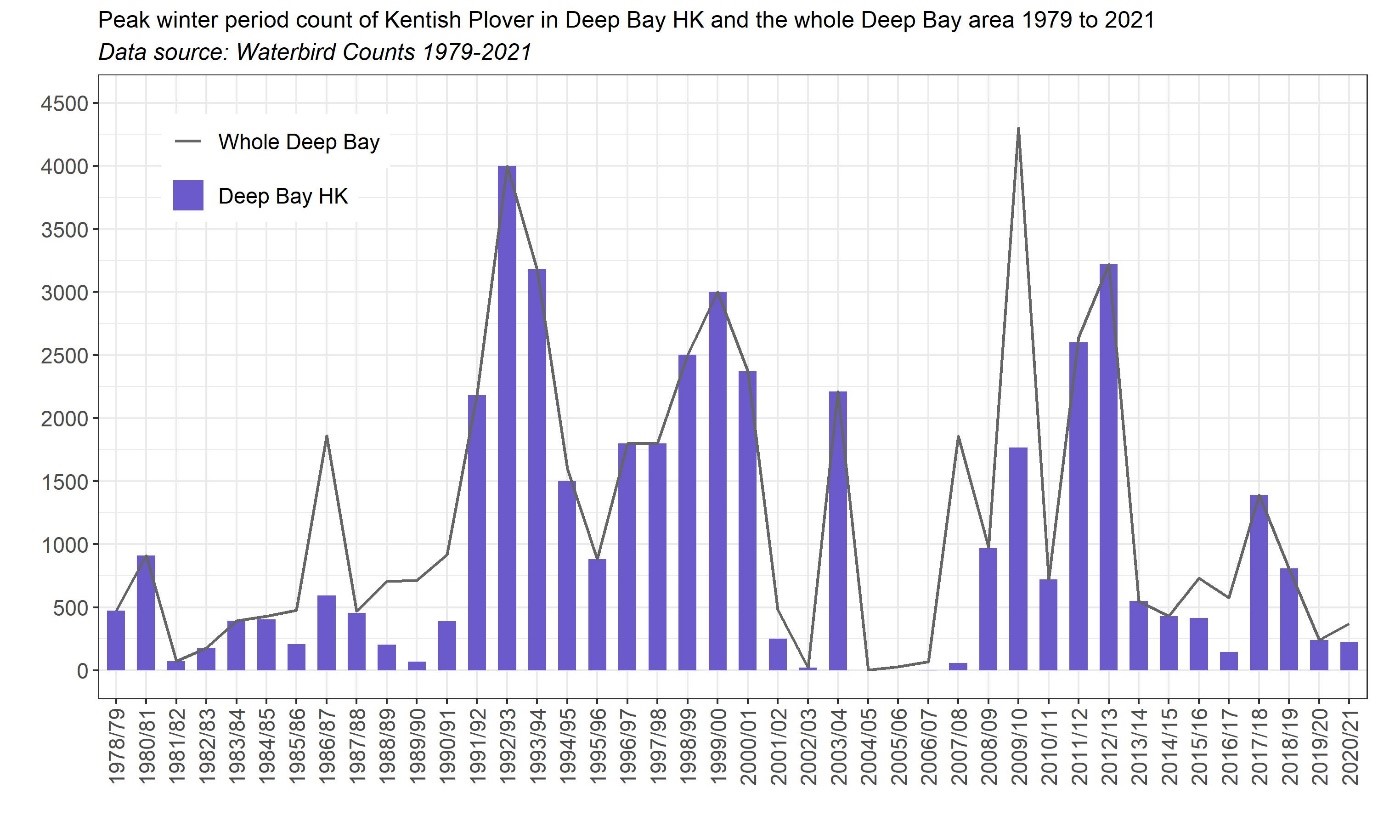Kentish Plover Anarhynchus alexandrinus 環頸鴴
Category I. Abundant winter visitor and scarce passage migrant to intertidal areas of Deep Bay.
IDENTIFICATION

Apr. 2021, John and Jemi Holmes. Male, breeding plumage.
15-17.5 cm. The default small plover on the intertidal mudflats in the winter months. Rather compact with a relatively large and flat-crowned head; pale collar separates from sand plovers. Dark lores, small patches at side of breast and white chest, prominent wing bar and sides to tail in flight. Adult male in breeding plumage has neat black head markings and warm brown rear of crown, which are duller in winter.

Nov. 2021, Michelle and Peter Wong.
Female head pattern much duller, lacking black. Remaining buff fringes to upperparts indicate this is a first-winter bird.

Sep. 2017, Michelle and Peter Wong. First-year.
First-years early in the winter can be identified by obvious pale fringes to the upperpart feathers.
VOCALISATIONS
Most commonly heard is a rich trill uttered as a call of alarm or excitement.
Other calls include single or double short notes.
Also gives an inflected ‘duweet’, often with the rich trilling call.
DISTRIBUTION & HABITAT PREFERENCE
Throughout the year most birds are recorded on the intertidal mudflats of Deep Bay. Elsewhere, since 1999 up to 28 birds have been recorded at soft shore coastal sites throughout HK. In contrast Carey et al. (2001) noted higher numbers at non-Deep Bay sites, with up to 175 (though generally fewer than 100) at the former and present airports of Kai Tak and Chek Lap Kok and up to 46 at Shuen Wan.
OCCURRENCE
Figure 1 illustrates the peak winter count since 1979, and while the lower counts prior to the mid-1980s were likely due in part to the limited access to Inner Deep Bay, there does appear to have been a marked increase in wintering birds from the early 1990s to the end of the century. Numbers are somewhat variable due to the erratic nature of the appearance of small waders in front of the intertidal mudflat hides. Indeed, in January 2002 there was a count of 4,000 Dunlin and/or Kentish Plover suggesting that number remained somewhat higher than is indicated. Very low numbers were recorded from winter 2004/05 to winter 2007/08, but this was followed by higher, albeit rather variable numbers since. Numbers in recent winter periods have been relatively low, but it is difficult to detect a trend. The highest count is 4,000 during 12-13 December 1992 and on 5 February 1998, while the highest count for Deep Bay as a whole is 4,303 on 24 January 2010.
Counts of over 1,000 have been made as late as the third week of March, but in general departure of the bulk of the wintering population occurs earlier than this. The period from mid-April to late September generally sees rather few birds present, and no records have occurred in the period 21 June to 8 July. The first three figure counts of the autumn have occurred at the end of September, after which numbers increase as the wintering population arrives.
Although Vaughan and Jones (1913) referred to only one January record, Swinhoe (1861) before them and both Dove and Goodhart (1955) and Macfarlane and Macdonald (1966) subsequently indicated that the status of Kentish Plover was much as it is today.
BEHAVIOUR, FORAGING & DIET
The wintering flock is seen almost exclusively in the intertidal areas, but high tide roost sites are unknown. As with Dunlin, birds often depart the foraging area when the tide is relatively low, unlike other shorebirds.
Frequently employs foot-trembling when foraging. Although presumably feeds mainly on intertidal crustaceans, no concrete information.
RANGE & SYSTEMATICS
Breeds from western Europe and north Africa east through the Middle East and central Asia to east Asia as far as Japan. Northerly breeding birds winter south in both coastal and inland areas of Africa, the Indian subcontinent and much of southeast Asia; southerly populations are resident. In China a summer visitor to lowland areas across the northern half and a winter visitor south of the Yangtze (Liu and Chen 2021).
Three subspecies are recognised, two of which could occur in HK. The nominate breeds from Europe and north Africa east to north China, while A. a. nihonensis breeds in southeast Russia, northeast and east China including Taiwan, the Korean Peninsula and Japan. A. a. seebohmi breeds in south India and Sri Lanka.
CONSERVATION STATUS
IUCN: Least Concern. Population trend decreasing.
Figure 1.

Dove, R. S. and H. J. Goodhart (1955). Field observations from the Colony of Hong Kong. Ibis 97: 311-340.
Liu, Y. and S. H. Chen (eds) (2021). The CNG Field Guide to the Birds of China (in Chinese). Hunan Science and Technology Publication House, Changsha.
Macfarlane, A. M. and A. D. Macdonald, revised by Caunter, J. R. L. and A. M. Macfarlane (1966). An Annotated Check-list of the Birds of Hong Kong. Hong Kong Bird Watching Society, Hong Kong.
Swinhoe, R. (1861). Notes on the ornithology of Hong Kong, Macao and Canton, made during the latter end of February, March, April and the beginning of May 1860. Ibis 1861: 23-57.
Vaughan, R. E. and K. H. Jones (1913). The birds of Hong Kong, Macao and the West River or Si Kiang in South-East China, with special reference to their nidification and seasonal movements. Ibis 1913: 17-76, 163-201, 351-384.

